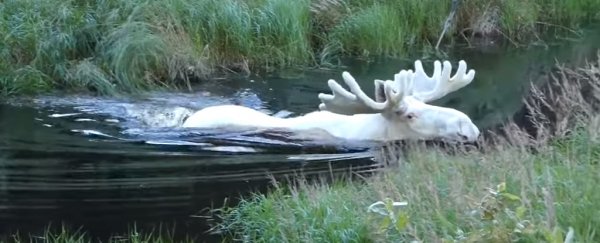Last Friday, Hans Nilsson in Sweden finally caught sight of an elusive creature he'd been trying to capture on film for three years straight.
He spoke about the experience to Swedish national radio, and just a couple days later his footage of the incredibly rare, incredibly majestic white moose is in the process of breaking the internet. So, how rare exactly are these beautiful creatures?
Before we go into the whys and hows of this really pasty moose (look! even the antlers are white and fuzzy!), please enjoy Nilsson's footage below, courtesy P4 Värmland Sveriges Radio:
Ahhh. So beautiful.
Scandinavia is full of moose (Alces alces, also called elk) - the native range of this massive deer family member stretches in an even band across the northern parts of the Northern Hemisphere. Most of them are dark brown of course, but white ones do form a small part of the population.
Just a couple months ago two white moose calves were also sighted in Norway - the baby twins were thought to be about a month old at that point.
Sightings of white moose actually seem to crop up every year or so, and not just from Europe. Last year one such creature spotted in Alaska made headlines around October, and one mottled specimen was caught on film in Canada's Newfoundland just the year before.
Nilsson is a councilman at Eda Municipality in western Sweden's Värmland county, right on the border with Norway. He says there are about 50 white moose in his region, which seems like a lot, considering the BBC claims there are only about 100 of these animals in the whole of Sweden, out of a total of about 400,000.
There's actually no official database or register of Swedish white moose, so we don't know what the actual numbers might be.
But it does appear that if you want to see a white moose, Värmland county is the place to be. In 2012, a group of sightseers were also lucky to encounter one in this region:

"We hadn't gotten very far from our house though when we spotted something extremely, extremely cool by the side of the road - a genuine, real live white moose," states the video caption.
"He was standing so still that at first we didn't think he was real. [That is], obviously he was real, but we thought it might be a statue."
Another white moose - this time female, without antlers - was also spotted in Värmland in 2009. The man loped after it into the forest for about 400 metres (0.25 miles), hence the heavy breathing in the video below:

One interesting fact is that these white moose are usually not considered albino. Instead, the white appearance is thought to stem from a recessive gene that leads to a mottled situation where the white fur is interspersed with flecks of brown (this is known as a piebald moose).
As Swedish biologist Göran Ericsson explained to National Geographic, because white moose are cropping up nearly every year, he's been wondering whether the animals are increasing in the population.
There are few predators for moose in Sweden, although they are a popular target during the hunting season. But apparently hunters choose not to shoot white moose, which could be causing a sort-of selective effect here.
"It is kind of like dog breeding," said Ericsson. "They [hunters] choose to select for traits that otherwise wouldn't have occurred."
